The last frontier.
As I’m clueless about the tech aspects, I have handed over this latest Hackintosh column to pseudonymous Hackintosh ace and all around good egg FU Steve:
“Thanks, Thomas. Your own recent upgrades to Blu-Ray capability in your HackMini make what follows especially timely.
A brief summary of Hackintosh creation shows that it involves two fields.
Hardware: The Hackintosh is made of cheap stock PC parts, available from many online vendors or from your local Fry’s Electronics. The hardware aspect of the ‘build’ has always been the easy part, and it’s literally no more difficult than making a Lego toy. If there’s a tricky bit it’s inserting those fiddly connectors for the front panel power switches and the LED activity lights, as those are not keyed. No smoke results if you get these wrong – just try again. As for the rest of it, all connectors are keyed and it’s impossible to get them wrong. For brands, the only ones which matter are Intel CPUs and Gigabyte motherboards, because that’s what the Hackintosh community favors. While ATI make some nice Radeon GPUs, if you are using a separate graphics card – increasingly unnecessary in these days of excellent integrated GPUs which come with the CPU – then nVidia is the way to go. It does not pay to be a pioneer here – stick with the GTX6xx series or earlier. Let the GTX7xx lads do the bleeding for you first. Other than those, nothing else is brand sensitive. Have at it when it comes to memory, power supplies, cases, keyboards, displays, speakers, etc. The world is your oyster. The only honorable exception is wi-fi where you simply must use the TP-Link wi-fi card. It’s $42, plug and play, confers full Airport capability and life is too short for the alternatives.
Software: Always the witches brew when it comes to Hackintoshes. Back in the OS Tiger days this was truly a job only for masochists and the terminally insane. Today, with Mountain Lion and superb free tools from Tonymacx86.com (time for a name change, guys?) hacking OS X to run on your PC parts has never been easier. Not as trivial as the hardware part, but follow the excellent instructions on that site and you will succeed, aided by an enthusiastic membership.
But there remains one aspect of software hacking which is still in the Dark Ages, and that is the process of getting the HDMI socket on modern builds to convey audio.
A brief history. A few years ago VGA (Video Graphics Array) was the way to go. IBM’s brilliant invention conveyed video through 15 pin connectors from the Hack to your display of choice. Sound was carried on a separate 3.5mm coaxial cable (or cables, for multichannel sound). VGA is robust, very easy to implement – nothing needs be done most of the time – and delivers excellent analog video.
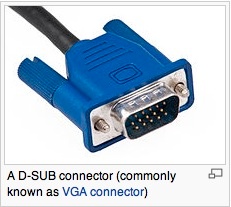
Then along came DVI (Digital Video Interface) in a bewildering set of variations:

And one or more of these is what every Hack and most PCs use to convey video to a display with, once again, a separate cable for audio. DVI video can be analog or digital, depending on the connector, whereas the audio remains analog over the separate cable.
With the advent of large flat panel TVs the need to simplify things saw the creation of HDMI, the High-Definition Multimedia Interface, which conveys video and audio, both in purest digital, from Hackintosh to TV set. Getting video working requires only that an HDMI cable be connected between TV set and the Hackintosh. It’s audio which is an SOB. The problem is that getting HDMI working on a Hack is sheer bloody hell. There is no standardization, many software apps are needed, the hacking involves the most arcane changes to code in various files and the results are anything but guaranteed. Just look at the length of the discussion on this topic on the above referenced board and you will see they frequently stretch to dozens of pages and hundreds of postings, many issues remaining unresolved. So the Hackintosh community definitely needs to go where no man has gone before and come up with an app to do this for all but the code monkeys of the world.
But there is a simpler solution. Having tried – and failed – to make Thomas’s HackMini enable its HDMI socket audio (via his nVidia GT430 graphics card), I resorted to the easy fix. Using TonyMac’s Multibeast I added the Voodoo kext to his System->Library->Extensions directory and then moved the existing AppleHDA.kext to an applications directory for storage. The two do not coexist. Then I rebuilt permissions, just to be safe. Here’s what I’m talking about:
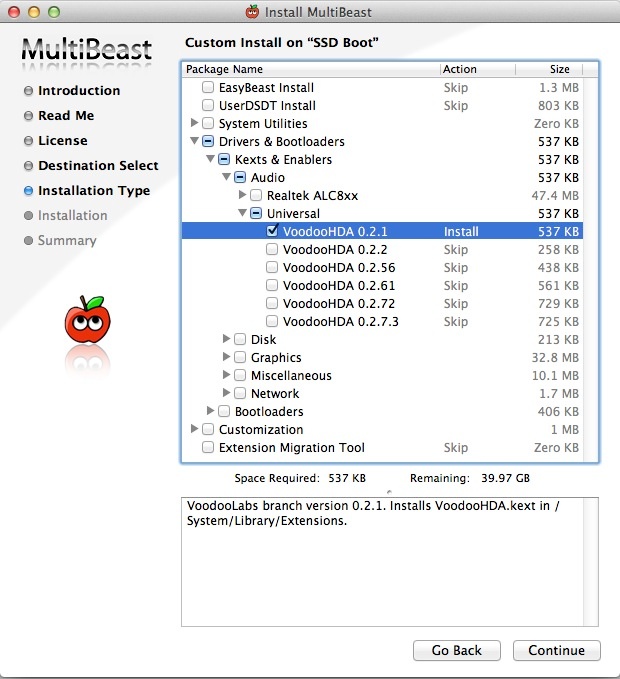
There are several versions of Voodoo – just keep trying until one works. The first did the trick for me.
Then you need to go into Applications->Utilities->AudioMidi Setup and dial in 48000 Hz as the Format, thus:
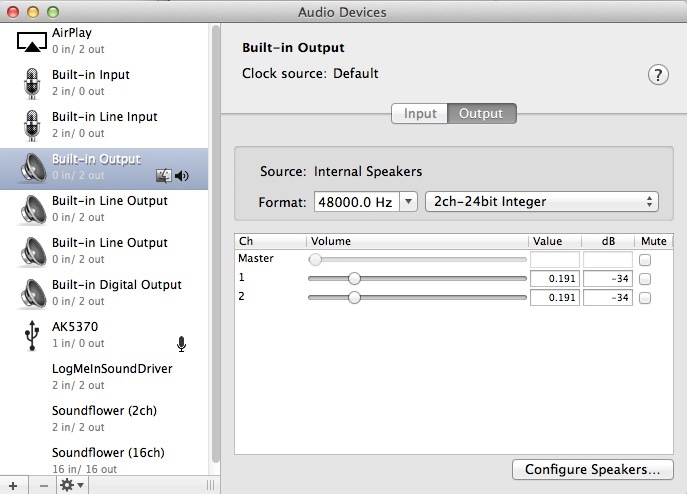
Restart and you will have working HDMI video and audio, the latter after going into SystemPreferences->Sound->Output and choosing one of the four ‘Digital’ options – try one after the other until it works. No need to restart for this step.
The upside of the Voodoo approach is that it’s fast and easy. The downside is that if you restart the Hack you may need to redo the AudioMidi Setup step, which takes all of five seconds. Further, you will be limited to 2+1 channel sound, not the 5+1 or 7+1 offered by the proper hack. Until the Hackintosh community develops a systematic hack to get HDMI audio working, this is the easiest way.”
Thank you, FU. Now my Blu-Ray experience is complete …. until I add a 90″ Sharp LED display and 7+1 surround sound, that is!
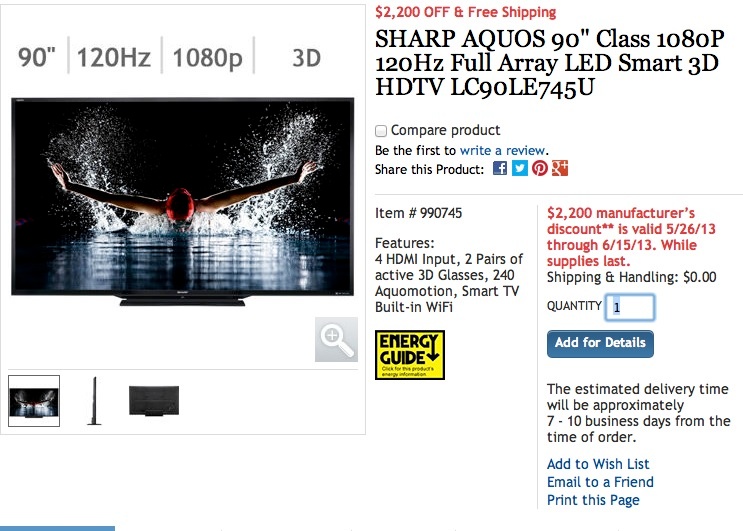
The Sharp 90″ newly listed by Costco – for all of $7,500.
Remember when the Pioneer 104″ was $100,000 not so long ago?
The other night I was watching the opening of Once Upon a Time in the West where the steam train idles while Charles Bronson gets off to meet the assassins. The breathing of the train’s massive piston is like nothing I have ever heard, and HDMI digital audio is to thank for that. I then changed to Steve McQueen’s Le Mans also in Blu-Ray and reveled in the sound of two of the greatest endurance racers ever – the brute Porsche 917 and the beautiful Ferrari 512. Though calling any Ferrari ‘beautiful’ is an exercise in the tautological. Just ‘Ferrari’ suffices.
If you have not yet done so, I encourage you to look into adding HDMI connections for video and audio to your TV. Beware that the colors are all over the place after using VGA so be prepared to re-tune things.
For those disinclined to build a Hackintosh, the only Apple solution is in the current MacMini which is the only Mac which an HDMI output:
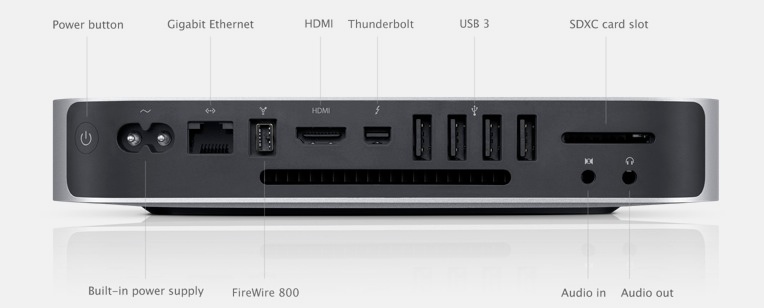
Of course, you will have to add external storage and an external BluRay drive if you want to watch Blu-Ray movies and rip them for storage. Also hope the gadget doesn’t overheat. Apple claims the HDMI output delivers audio and video; I have not tested it, nor will I be. New MacMinis start at $600. The cheapest version with an SSD runs some $1,099 with 4GB RAM and no DVD drive, which is outrageous. Used mid-2010 (the one with HDMI added) can be found on eBay for $400.
